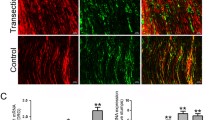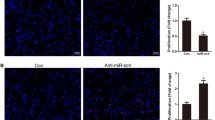Abstract
Endothelial cells are important components of peripheral nerve stumps that contribute to Schwann cell migration and peripheral nerve regeneration. Let-7d modulates the phenotype of Schwann cells and affected peripheral nerve regeneration. However, the regulatory roles of let-7d on endothelial cells remain undetermined. In this study, by transfecting cultured human umbilical vein endothelial cells (HUVECs) with let-7d mimic or let-7d inhibitor, we investigated the biological effects of let-7d on endothelial cells. EdU proliferation assay showed that upregulated let-7d decreased the proliferation rates of HUVECs while downregulated let-7d increased the proliferation rates of HUVECs. Transwell-based migration assay and wound-healing assay demonstrated that let-7d inhibited the migration ability of HUVECs. Matrigel assay suggested that let-7d decreased the numbers of formed meshes and suppressed the tubulogenesis of HUVECs. RNA sequencing, bioinformatic analysis, gene expression validation, and luciferase assay suggested that let-7d directly targeted interferon-induced protein 44 like (IFI44L) gene and negatively regulated the expression of IFI44L. Taken together, our study illuminated the inhibitory roles of let-7d on the proliferation, migration, and tubulogenesis of endothelial cells, identified the target gene of let-7d, and deepened the understanding of the biological effects of let-7d on key elements of peripheral nerve regeneration.





Similar content being viewed by others
References
Gu X, Ding F, Yang Y, Liu J (2011) Construction of tissue engineered nerve grafts and their application in peripheral nerve regeneration. Prog Neurobiol 93(2):204–230. https://doi.org/10.1016/j.pneurobio.2010.11.002
Li R, Liu Z, Pan Y, Chen L, Zhang Z, Lu L (2014) Peripheral nerve injuries treatment: a systematic review. Cell Biochem Biophys 68(3):449–454. https://doi.org/10.1007/s12013-013-9742-1
Qian T, Wang P, Chen Q, Yi S, Liu Q, Wang H, Wang S, Geng W, Liu Z, Li S (2018) The dynamic changes of main cell types in the microenvironment of sciatic nerves following sciatic nerve injury and the influence of let-7 on their distribution. RSC Adv 8(72):41181–41191
Cattin AL, Burden JJ, Van Emmenis L, Mackenzie FE, Hoving JJ, Garcia Calavia N, Guo Y, McLaughlin M, Rosenberg LH, Quereda V, Jamecna D, Napoli I, Parrinello S, Enver T, Ruhrberg C, Lloyd AC (2015) Macrophage-induced blood vessels guide Schwann cell-mediated regeneration of peripheral nerves. Cell 162(5):1127–1139. https://doi.org/10.1016/j.cell.2015.07.021
Jessen KR, Mirsky R (2019) The success and failure of the schwann cell response to nerve injury. Front Cell Neurosci 13:33. https://doi.org/10.3389/fncel.2019.00033
Carr MJ, Johnston AP (2017) Schwann cells as drivers of tissue repair and regeneration. Curr Opin Neurobiol 47:52–57. https://doi.org/10.1016/j.conb.2017.09.003
Jessen KR, Mirsky R, Lloyd AC (2015) Schwann cells: development and role in nerve repair. Cold Spring Harb Perspect Biol 7(7):a020487. https://doi.org/10.1101/cshperspect.a020487
Bouis D, Kusumanto Y, Meijer C, Mulder NH, Hospers GA (2006) A review on pro- and anti-angiogenic factors as targets of clinical intervention. Pharmacol Res 53(2):89–103. https://doi.org/10.1016/j.phrs.2005.10.006
Caillaud M, Richard L, Vallat JM, Desmouliere A, Billet F (2019) Peripheral nerve regeneration and intraneural revascularization. Neural Regen Res 14(1):24–33. https://doi.org/10.4103/1673-5374.243699
Muangsanit P, Shipley RJ, Phillips JB (2018) Vascularization strategies for peripheral nerve tissue engineering. Anat Rec (Hoboken) 301(10):1657–1667. https://doi.org/10.1002/ar.23919
Yu B, Zhou S, Yi S, Gu X (2015) The regulatory roles of non-coding RNAs in nerve injury and regeneration. Prog Neurobiol 134:122–139. https://doi.org/10.1016/j.pneurobio.2015.09.006
Li S, Wang X, Gu Y, Chen C, Wang Y, Liu J, Hu W, Yu B, Wang Y, Ding F, Liu Y, Gu X (2015) Let-7 microRNAs regenerate peripheral nerve regeneration by targeting nerve growth factor. Mol Ther: J Am Soc Gene Ther 23(3):423–433. https://doi.org/10.1038/mt.2014.220
Wang X, Chen Q, Yi S, Liu Q, Zhang R, Wang P, Qian T, Li S (2019) The microRNAs let-7 and miR-9 down-regulate the axon-guidance genes Ntn1 and Dcc during peripheral nerve regeneration. J Biol Chem 294(10):3489–3500. https://doi.org/10.1074/jbc.RA119.007389
Bartel DP (2018) Metazoan MicroRNAs. Cell 173(1):20–51. https://doi.org/10.1016/j.cell.2018.03.006
Jiang Q, Wang Y, Hao Y, Juan L, Teng M, Zhang X, Li M, Wang G, Liu Y (2009) miR2Disease: a manually curated database for microRNA deregulation in human disease. Nucleic Acids Res 37(Database issue):D98–104. https://doi.org/10.1093/nar/gkn714
Yu B, Zhou S, Wang Y, Ding G, Ding F, Gu X (2011) Profile of microRNAs following rat sciatic nerve injury by deep sequencing: implication for mechanisms of nerve regeneration. PLoS ONE 6(9):e24612. https://doi.org/10.1371/journal.pone.0024612
Li S, Yu B, Wang Y, Yao D, Zhang Z, Gu X (2011) Identification and functional annotation of novel microRNAs in the proximal sciatic nerve after sciatic nerve transection. Sci China Life Sci 54(9):806–812. https://doi.org/10.1007/s11427-011-4213-7
Yi S, Yuan Y, Chen Q, Wang X, Gong L, Liu J, Gu X, Li S (2016) Regulation of Schwann cell proliferation and migration by miR-1 targeting brain-derived neurotrophic factor after peripheral nerve injury. Sci Rep 6:29121. https://doi.org/10.1038/srep29121
Li S, Zhang R, Yuan Y, Yi S, Chen Q, Gong L, Liu J, Ding F, Cao Z, Gu X (2017) MiR-340 regulates fibrinolysis and axon regrowth following sciatic nerve injury. Mol Neurobiol 54(6):4379–4389. https://doi.org/10.1007/s12035-016-9965-4
Yi S, Wang QH, Zhao LL, Qin J, Wang YX, Yu B, Zhou SL (2017) miR-30c promotes Schwann cell remyelination following peripheral nerve injury. Neural Regen Res 12(10):1708–1715. https://doi.org/10.4103/1673-5374.217351
Huang WC, Tung SL, Chen YL, Chen PM, Chu PY (2018) IFI44L is a novel tumor suppressor in human hepatocellular carcinoma affecting cancer stemness, metastasis, and drug resistance via regulating met/Src signaling pathway. BMC Cancer 18(1):609. https://doi.org/10.1186/s12885-018-4529-9
Gaudet P, Livstone MS, Lewis SE, Thomas PD (2011) Phylogenetic-based propagation of functional annotations within the Gene Ontology consortium. Br Bioinform 12(5):449–462. https://doi.org/10.1093/bib/bbr042
Schoggins JW, Wilson SJ, Panis M, Murphy MY, Jones CT, Bieniasz P, Rice CM (2011) A diverse range of gene products are effectors of the type I interferon antiviral response. Nature 472(7344):481–485. https://doi.org/10.1038/nature09907
Acknowledgements
This study was supported by National Natural Science Foundation of China (Grant No. 31700926) and Priority Academic Program Development of Jiangsu Higher Education Institutions (PAPD). The authors are grateful for Dr. Mi Shen for providing human umbilical vein endothelial cells (HUVECs).
Author information
Authors and Affiliations
Contributions
SY: conceived and designed the experiments. XJ, HH, SY and YS: performed the experiments. XJ, HH, SB and SY: analyzed the data. BS and SY: contributed reagents/materials/analysis tools. XJ and SY: wrote the manuscript.
Corresponding authors
Ethics declarations
Conflict of interest
The authors declare that they have no conflict of interest.
Additional information
Publisher's Note
Springer Nature remains neutral with regard to jurisdictional claims in published maps and institutional affiliations.
Electronic supplementary material
Below is the link to the electronic supplementary material.
11010_2019_3611_MOESM1_ESM.xlsx
Supplementary material 1—List of potential targets of let-7d predicted by Miranda, RNAhybrid, and TargetScan. (XLSX 6819 kb)
Rights and permissions
About this article
Cite this article
Ji, X., Hua, H., Shen, Y. et al. Let-7d modulates the proliferation, migration, tubulogenesis of endothelial cells. Mol Cell Biochem 462, 75–83 (2019). https://doi.org/10.1007/s11010-019-03611-x
Received:
Accepted:
Published:
Issue Date:
DOI: https://doi.org/10.1007/s11010-019-03611-x




